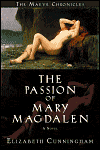
Mary Magdalen, just barely mentioned in the Bible, heroine of her own gnostic gospel, and possibly the most beloved disciple of Jesus the Christ, has hit the big time. From Holy Blood/Holy Grail to The Da Vinci Code, she’s come out of the shadows behind orthodox cliché and is now a full-blown hera to women seeking a Christian goddess. Or a Gnostic goddess. Or a literate goddess. Or a goddess of older ways. Like the Tarot High Priestess, she’s our projection holder. We can see her as Margaret Starbird does—as Mary of Bethany, the “bride in exile”—or through the pen of Elizabeth Cunningham as the Holy Whore. Yes, the Fathers of the Church and leading biblical scholars see her as a whore, but to them she’s never holy. She’s the unnamed woman filled with seven demons that Jesus casts out. She’s the prostitute who comes with her alabaster jar full of expensive unguent to wash Jesus’ feet. Some feminist scholars see this act as a symbolic hieros gamos, with Magdalen as a priestess representing the Goddess and Jesus becoming Her king.
Cunningham’s Magdalen is a red-headed Celt named Maeve. She’s the daughter of the Shining Isles (that’s the title of the prequel, which was written earlier but is now available only as a used book), who is raised by eight legendary mothers. While still a child, she has an involuntary vision of someone with “an appendage.” When she’s sent to the druids’ school on Mona, she meets a foreign student named Esus. He’s the one with the appendage! He’s Jewish and Mona is, presumably, where Jesus spent his famous “lost years” (though in “real life,” he was most likely herding sheep around Nazareth). He’s scholarly and disputatious, and he and Maeve fall in love. Read Daughter of the Shining Isles for a story that will tear your heart out. It ends with Maeve adrift in the North Atlantic in a coracle.
When The Passion of Mary Magdalen opens, Maeve is on the slave block in Rome. She’s purchased by an aristocratic madam. Learning the trade, she spends her first professional night with a general:
As I look back on that night [Maeve tells us in her anachronistic, take-no-prisoners voice], I see choices I didn’t recognize then. I could have disavowed my body. That’s not me straddling the general. That’s just my body. Or I could become my body, its opening and resistance, its capacity for cruelty or compassion. But there is another possibility, and I think I sensed it even then: that I—thus fraught, ecstatic coupling of body and soul—could become the conduit of some wild force, the mediator of it, the priestess (p. 27).
Turn off your phone and computer, cancel your life, eat delivered fast food, let the laundry pile up. Once you read page 1, you won’t want to put the book down until you close it at the end of page 620. You’ll learn that the lives of Roman women and slaves were more alike than we imagine today. You’ll visit the Grove of Nemi (where the golden bough is). You’ll meet priestesses of Isis and Diana. You’ll meet people of history and legend. Cunnningham has done her homework: she’s read the Roman and Jewish historians, she’s read the Gospels, she’s read modern scholarship. She even traveled to Italy and Israel to see the sites for herself.
In Daughter of the Shining Isles, an old prophetess tells looks into a well and tells Maeve that she and Esus are lovers of each other and “lovers of the world.” Maeve spends the first half of The Passion of Mary Magdalen yearning for her beloved. Through a plot turn based on actual history, she’s freed and settles in the town of Magdala, where she builds a temple and develops a reputation as a healer. A Samaritan merchant brings a wounded man to her door. She spends the night holding this man, power flowing through her hands into his heart. He spends a month with her at the temple among the holy whores. The wounded man is Jesus. The second half of the novel retells the Synoptic Gospels. Maeve/Mary meets all the biblical figures, including the twelve disciples, but her version of the events of Jesus’ ministry is not what we’ve read before. While Jesus is being transfigured on Mount Hermon, Maeve and the other women come to a sacred grove. Mary is given her own ministry:
“He will be scattered,” the goddess said. “He will be torn to pieces. You must gather the lost pieces and make him whole. You must wash his wounds with your tears and give him life. Do you understand your task?” (p. 510).
~review by Barbara Ardinger, Ph.D.
Author: Elizabeth Cunningham
Monkfish Publishing, 2006
